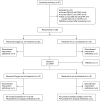Effect of Supplemental Oxygen on Blood Pressure in Obstructive Sleep Apnea (SOX). A Randomized Continuous Positive Airway Pressure Withdrawal Trial
- PMID: 30025470
- PMCID: PMC6353003
- DOI: 10.1164/rccm.201802-0240OC
Effect of Supplemental Oxygen on Blood Pressure in Obstructive Sleep Apnea (SOX). A Randomized Continuous Positive Airway Pressure Withdrawal Trial
Abstract
Rationale: Obstructive sleep apnea (OSA) is associated with systemic hypertension. Either overnight intermittent hypoxia, or the recurrent arousals that occur in OSA, could cause the daytime increases in blood pressure (BP).
Objectives: To establish the role of intermittent hypoxia in the increased morning BP in patients with OSA.
Methods: Randomized, double-blinded, crossover trial assessing the effects of overnight supplemental oxygen versus air (sham) on morning BP, after continuous positive airway pressure (CPAP) withdrawal in patients with moderate to severe OSA. The primary outcome was the change in home morning BP after CPAP withdrawal for 14 nights, oxygen versus air. Secondary outcomes included oxygen desaturation index (ODI), apnea-hypopnea index (AHI), subjective sleepiness (Epworth Sleepiness Scale score), and objective sleepiness (Oxford Sleep Resistance Test).
Measurements and main results: Supplemental oxygen virtually abolished the BP rise after CPAP withdrawal and, compared with air, significantly reduced the rise in mean systolic BP (-6.6 mm Hg; 95% confidence interval [CI], -11.3 to -1.9; P = 0.008), mean diastolic BP (-4.6 mm Hg; 95% CI, -7.8 to -1.5; P = 0.006), and median ODI (-23.8/h; interquartile range, -31.0 to -16.3; P < 0.001) after CPAP withdrawal. There was no significant difference, oxygen versus air, in AHI, subjective sleepiness, or objective sleepiness.
Conclusions: Supplemental oxygen virtually abolished the rise in morning BP during CPAP withdrawal. Supplemental oxygen substantially reduced intermittent hypoxia, but had a minimal effect on markers of arousal (including AHI), subjective sleepiness, or objective sleepiness. Therefore intermittent hypoxia, and not recurrent arousals, appears to be the dominant cause of daytime increases in BP in OSA.
Keywords: blood pressure; intermittent hypoxia; obstructive sleep apnea.
Figures



Comment in
-
Supplemental Oxygen for Obstructive Sleep Apnea: Is There a Role After All?Am J Respir Crit Care Med. 2019 Jan 15;199(2):140-141. doi: 10.1164/rccm.201807-1216ED. Am J Respir Crit Care Med. 2019. PMID: 30063842 No abstract available.
-
Reply to Jin et al.: Supplemental Oxygen in Obstructive Sleep Apnea: Much to Be Done.Am J Respir Crit Care Med. 2019 Jan 1;199(1):127. doi: 10.1164/rccm.201808-1487LE. Am J Respir Crit Care Med. 2019. PMID: 30211614 Free PMC article. No abstract available.
-
Supplemental Oxygen in Obstructive Sleep Apnea: Much to Be Done.Am J Respir Crit Care Med. 2019 Jan 1;199(1):126-127. doi: 10.1164/rccm.201807-1417LE. Am J Respir Crit Care Med. 2019. PMID: 30211619 No abstract available.
Similar articles
-
Long-term effect of continuous positive airway pressure in hypertensive patients with sleep apnea.Am J Respir Crit Care Med. 2010 Apr 1;181(7):718-26. doi: 10.1164/rccm.200901-0050OC. Epub 2009 Dec 10. Am J Respir Crit Care Med. 2010. PMID: 20007932 Clinical Trial.
-
Effects of continuous positive airway pressure therapy withdrawal in patients with obstructive sleep apnea: a randomized controlled trial.Am J Respir Crit Care Med. 2011 Nov 15;184(10):1192-9. doi: 10.1164/rccm.201106-0964OC. Am J Respir Crit Care Med. 2011. PMID: 21836134 Clinical Trial.
-
The effects of Provent on moderate to severe obstructive sleep apnoea during continuous positive airway pressure therapy withdrawal: a randomised controlled trial.Thorax. 2013 Sep;68(9):854-9. doi: 10.1136/thoraxjnl-2013-203508. Epub 2013 May 30. Thorax. 2013. PMID: 23723343 Clinical Trial.
-
Continuous Positive Airway Pressure vs Mandibular Advancement Devices in the Treatment of Obstructive Sleep Apnea: An Updated Systematic Review and Meta-Analysis.Cureus. 2022 Jan 31;14(1):e21759. doi: 10.7759/cureus.21759. eCollection 2022 Jan. Cureus. 2022. PMID: 35251830 Free PMC article. Review.
-
Is There a Role for Continuous Positive Airway Pressure Treatment in the Management of Obstructive Sleep Apnea-related Hypertension?Curr Hypertens Rev. 2017;13(2):89-92. doi: 10.2174/1573402113666170612094750. Curr Hypertens Rev. 2017. PMID: 28606037 Review.
Cited by
-
Obstructive sleep apnea and pulmonary hypertension: a bidirectional relationship.J Clin Sleep Med. 2020 Aug 15;16(8):1223-1224. doi: 10.5664/jcsm.8660. J Clin Sleep Med. 2020. PMID: 32807290 Free PMC article.
-
International Consensus Statement on Obstructive Sleep Apnea.Int Forum Allergy Rhinol. 2023 Jul;13(7):1061-1482. doi: 10.1002/alr.23079. Epub 2023 Mar 30. Int Forum Allergy Rhinol. 2023. PMID: 36068685 Free PMC article. Review.
-
Obstructive sleep apnoea and coronary artery disease.J Thorac Dis. 2018 Dec;10(Suppl 34):S4212-S4220. doi: 10.21037/jtd.2018.12.75. J Thorac Dis. 2018. PMID: 30687537 Free PMC article. Review.
-
Comparing the effects of supplemental oxygen therapy and continuous positive airway pressure on patients with obstructive sleep apnea: a meta-analysis of randomized controlled trials.Sleep Breath. 2021 Dec;25(4):2231-2240. doi: 10.1007/s11325-020-02245-4. Epub 2021 Jan 7. Sleep Breath. 2021. PMID: 33415654
-
Oxygen for the treatment of obstructive sleep apnoea hypopnoea syndrome.Breathe (Sheff). 2019 Sep;15(3):e104-e107. doi: 10.1183/20734735.0206-2019. Breathe (Sheff). 2019. PMID: 31777572 Free PMC article.
References
-
- Marin JM, Carrizo SJ, Vicente E, Agusti AGN. Long-term cardiovascular outcomes in men with obstructive sleep apnoea–hypopnoea with or without treatment with continuous positive airway pressure: an observational study. Lancet. 2005;365:1046–1053. - PubMed
-
- Peppard PE, Young T, Palta M, Skatrud J. Prospective study of the association between sleep-disordered breathing and hypertension. N Engl J Med. 2000;342:1378–1384. - PubMed
-
- Pepperell JCT, Ramdassingh-Dow S, Crosthwaite N, Mullins R, Jenkinson C, Stradling JR, et al. Ambulatory blood pressure after therapeutic and subtherapeutic nasal continuous positive airway pressure for obstructive sleep apnoea: a randomised parallel trial. Lancet. 2002;359:204–210. - PubMed
Publication types
MeSH terms
Substances
LinkOut - more resources
Full Text Sources
Other Literature Sources
Medical
Miscellaneous

